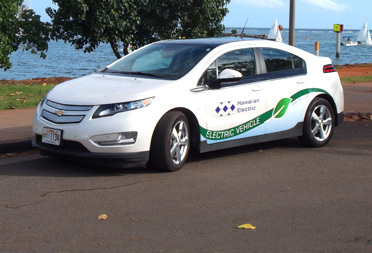
- Electric Vehicles
- Save Energy & Money
- Business Account Services
- Smart Renewable Energy Programs
- Customer Incentive Programs
Electrification of Transportation
Our Electrification of Transportation Strategic Roadmap describes our plans to reduce dependence on imported fossil fuel for transportation as well as electricity. Read full blog post
Electrification of Transportation (EoT) Strategic Roadmap
Renewable energy growth and electrification of transportation (EoT) are complementary, greater clean energy impacts and customer value can be created by achieving both in tandem. EoT will integrate with and support programs that facilitate integration of renewable energy, enable greater customer engagement and empowerment as "prosumers" of energy, and enhance grid efficiency and reliability by leveraging the flexibility of electrified vehicles.
To support these objectives and provide customer value, our EoT plans will align with and leverage our existing planning processes and programs, including the Integrated Grid Planning (IGP) process (which continues the work done in the Power Supply Improvement Plan, or PSIP), Grid Modernization Strategy (GMS), Demand Response (DR) and Distributed Energy Resources (DER) programs. Specifically, Hawaiian Electric plans to:
- Leverage the proposed DR program to offer drivers and fleet operators incentives for "smart" charging and provision of other grid services,
- Leverage technologies and data collection proposed in the GMS and DER dockets to enable EV drivers as "prosumers" who support DER adoption and broader grid reliability, and
- Use IGP to cost-effectively plan for forecast EV adoption and seek new opportunities to maximize the value of EVs to customers and as a resource to the grid.
Documents
Our Electrification of Transportation (EoT) Strategic Roadmap (PDF) details how the increased adoption of EVs will allow us to integrate even more renewables into our grid by encouraging battery charging demand during periods of the day when solar energy is abundant.
- November 29, 2018 - Addendum to the EoT Strategic Roadmap (PDF)
Our Electric Vehicle Critical Backbone Study: Planning Methodology (PDF) pinpoints areas where public EV charging options can create a "critical backbone" to support EV-driving commuters and tourists and help optimize operation of the electric grid.
- October 29, 2021 - Request to Commission to approve a Public Electric Vehicle Charger Expansion Project and cost recovery (PDF)
- October 29, 2019 - Electrification of Transportation Workplan (PDF)
Here are five key short-term steps that this plan describes in greater detail:
- Boosting EV adoption by working with automakers, dealerships and advocates to lower the cost and educate customers.
- Accelerating the buildout of charging infrastructure, especially in workplaces and multi-unit dwellings. Providing a critical backbone of reliable, public utility-owned chargers as the launching point from which the broader electric transportation and third party charging market in Hawaii can expand and solidify. Identifying and providing make-readies in gap areas to create opportunities for third party chargers that optimize grid and customer locations to meet driver needs.
- Supporting bus operators in transitioning to electric with targeted outreach and programs that reduce the upfront cost and provide practical charging solutions. From there, efforts can move to trucks and heavy equipment.
- Creating grid service opportunities by leveraging demand response programs and rates that incentivize EV charging to align with grid needs and save money for both drivers and all grid customers.
- Coordinating with ongoing grid modernization and planning efforts to ensure smooth integration of EVs into energy delivery networks and maximizing use of renewable resources.
Electrification of Transportation Input Workshop
We are undertaking an update of the Roadmap that will help chart a path for electrified transportation across Hawaiian Electric’s service territory over the next five years. The first step in developing an updated Roadmap is outreach and engagement. Below are graphic summaries of some of the discussions that have taken place. Please click on an image to enlarge. If you have any thoughts or suggestions about what should be considered, please submit your comments to emob@hawaiianelectric.com.
Webinars & Discussions
- March 6, 2024 - EoT Strategic Roadmap 2.0 Webinar - Final Draft Presentation | View Presentation Slides (PDF) | View Q&A (PDF)
- November 16, 2023 - EoT Strategic Roadmap 2.0 Webinar: Proposed Hawaiian Electric EoT Actions | View Proposed Hawaiian Electric EoT Presentation Slides (PDF) | View Summary of Breakout Group Discussions (PDF)
- June, 6, 2023 – Panel discussion on Customer Perspectives on Electrification of Transportation
- June 6, 2023 – Panel discussion on Equity, Affordability, and Accessibility for Electrification of Transportation
- December 9, 2021 - Drive Electric Dialogue #4: Charge Up eBus and Public EV Charger Expansion | View Charge Up eBus Presentation Slides (PDF) | View EV-U Expansion Filing Outreach Deck Presentation Slides (PDF)
- October 21, 2020 - Drive Electric Dialogue #3: Commercial Make-Ready Infrastructure
- July 29, 2020 - Drive Electric Dialogue #2: Charging Initiatives and the Critical Backbone Tool | View Dialogue #2 Q&A (PDF)
- June 10, 2020 - Drive Electric Dialogue #1: Commercial Make-Ready Infrastructure | View Dialogue #1 Q&A (PDF)


















